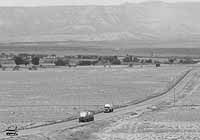| Ridge Road is one of the major projects the Carbon County Transportation Recreation Special Service District has funded with mineral lease royalties. |
The Carbon County Recreation/Transportation Service District Board met on Monday to make some adjustments to this year’s budget.
The budget was impacted by increasingly large payments from the state, as revenues for production of gas and coal continued to grow.
Payments come from money the federal government collects from private producers for extracting minerals. Fifty percent of the funds go to the state of Utah and the state in turn pays a percentage to the counties through special service districts, which serve to administer the funds.
This year payments have increased, but new accounting procedures have held back some of the funds until the end of the year. Last year the state legislature appropriated $16 million for these payments, but the actual incoming has added up to much more than that.
However, a new official at the Utah Department of Transporation who is in charge of distributing the funds has limited payments to $4 million per quarter until the end of the year at which time the excess will be paid.
Many counties and special service districts in the state receive some of the funds but Uintah County is getting the most at present.
In the first three quarters of 2003, Uintah County received $2,008,680.01
Actual payments to Carbon this year have included a $806,000 payment in February, $705,570 in May, $1,073,000 in August and $1,119,022 for this month.
It appears Carbon County will receive about another $1 million after the end of the year to reconcile.
The special service district operates out of three funds.
First is the general fund where the money that comes in is placed.
Next is the debt service fund that pays for long-term projects. One of the original debts the special service district incurred was the construction of Ridge Road to keep coal haul traffic away from the main population areas in the county.
Others include the Dugout Canyon Road as well as future funding for the Carbonville Road project.
The third is the capital projects fund, which the board subsidizes directly with money from the special service district’s coffers.
According to Bob Pero, who worked with the board at the meeting on the budget, the total expenditures in 2003 amounted to $3,435,000.
In other business, the board also voted to purchase some property near the golf course which the homeowners wish to sell. The property has a home on it and the total cost will be a little over $100,000.
Another highlight of the meeting was a presentation by Reece Barrick and Pam Miller of the College of Eastern Utah on the future of the CEU Prehistoric Museum.
“We are asking for help to get where we want and need to go,” said Barrick, who was named the new museum director and paleontologist a couple of months ago. “This area has a lot of resources that make it unique and we have a large collection with very little room left to store more.”
Barrick used a slide presentation to show the present and anticipated needs of the future based on the museum’s mission.
“We would like to expand exhibits because we have so much to show,” he said as he pointed to the model of an unnamed dinosaur that has been found in the area. “This animal was 80 feet long and, when he stood up, 30 feet high. We would like to find a way to display the fossils from this animal and many others.”
Barrick explained that neither of them were there necessarily looking for money, but that they had determined the museum needed a feasibility study done for expansion and hoped to find a way to come up with funds to do so. He asked if board members could come up with some ideas he would be very interested.
However, County Commissioner Mike Milovich, who was in the audience, said while he supported the museum 100 percent, he was concerned about some displays that are at the museum right now.
“These displays disparage the mineral extraction industry,” said Milovich. He then handed out photos of some placards that are placed by photos on the second level of the museum.
The display in which they appear is a temporary photographic display that was produced by a photographer whose work has been on exhibit in October.
Barrick didn’t realize that the placards were there and Miller said that she didn’t realize what they actually said either. All described the scenes of the photographs displayed but some also made comments about the development in the area where the photos were taken, which was in Nine Mile Canyon.
“The money from this board and other places in this county is what helps to develop projects,” said Milovich. “And that money comes from the mineral industry.”
Special service district board member Sam Quigley said he felt the museum should be a non-political entity.
“I don’t think the museum should take political stands on issues,” stated Quigley. “I don’t think we can fail to support the museum, but it should also not have one point of view expressed.”
The board also heard from Tom King, golf pro at the Carbon County Country Club. He pointed out that the course is trying to help greens regenerate by covering some of the ones that need protection the most for the winter with a special plastic covering.
“We have also fenced off some of the areas because elk are coming down and damaging some of them,” he said.
He also reported that people are still golfing and that over Thanksgiving weekend the course got quite a few Utah County golfers because of snowy conditions that existed on the other side of the mountain.

